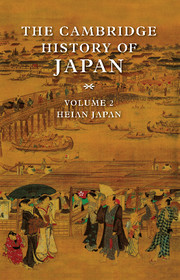Book contents
- Frontmatter
- Introduction
- 1 The Heian court, 794–1070
- 2 The capital and its society
- 3 Land and society
- 4 Provincial administration and land tenure in early Heian
- 5 Chinese learning and intellectual life
- 6 Aristocratic culture
- 7 Aristocratic Buddhism
- 8 Religious practices
- 9 Insei
- 10 The rise of the warriors
- Works cited
- Glossary-index
- Japan in the Heian period"
- References
4 - Provincial administration and land tenure in early Heian
Published online by Cambridge University Press: 28 March 2008
- Frontmatter
- Introduction
- 1 The Heian court, 794–1070
- 2 The capital and its society
- 3 Land and society
- 4 Provincial administration and land tenure in early Heian
- 5 Chinese learning and intellectual life
- 6 Aristocratic culture
- 7 Aristocratic Buddhism
- 8 Religious practices
- 9 Insei
- 10 The rise of the warriors
- Works cited
- Glossary-index
- Japan in the Heian period"
- References
Summary
The Heian era, as correctly portrayed in current studies, was characterized by a progressive weakening of centralized control over regional areas. Most of the administrative offices that had been established in the late seventh and eighth centuries for the purpose of maximizing state power declined rapidly during the early Heian period, with the notable exception of the headquarters offices at the capitals (kokufu) of the sixty-five (or sixty-six) provinces into which the country was divided. While the central government declined, these provincial offices (kokuga) retained, and even increased, their power over local land and people as local elites took over their functions: the collection of taxes, the administration of land, and the “promotion of agriculture” (kannō). The changes resulted in large part from movement from below, and, at least in the first two centuries of Heian times (the ninth and tenth centuries), had little to do with warriors or shōen (estates). The following discussion concentrates largely on those two centuries in an attempt to explain these changes. A more detailed inquiry, however, requires a preliminary discussion of local problems during the Heian period as a whole, and the problems they raise for us.
Managed by officials dispatched for short terms from the capital, the provincial offices were intended to be a new meeting ground for capital and local elites, enabling the dynastic state to marshal local resources and the loyal services of local aristocrats, but in practice the provincial governments turned out to be unique bargaining grounds for the division of resources between capital and countryside, and that function, combined with the functions of the governments as repositories and redistributors of wealth, ensured their survival well beyond the Heian period.
Keywords
- Type
- Chapter
- Information
- The Cambridge History of Japan , pp. 236 - 340Publisher: Cambridge University PressPrint publication year: 1999
References
- 6
- Cited by

